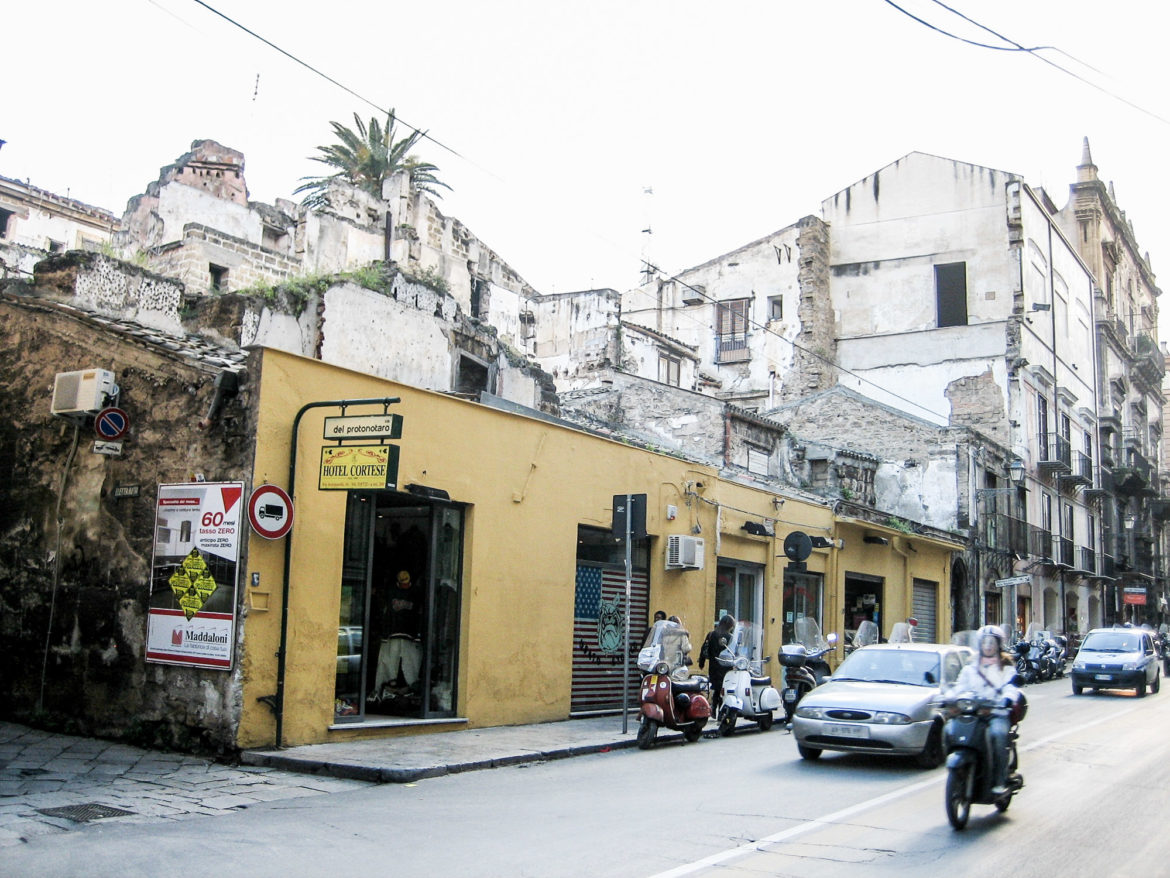Gritty streets. Noisy construction. Endless traffic.
Palermo definitely did not fit our vision of Sicily.
After a somewhat hallucinatory overnight train ride from mainland Italy (more on that here), we figured our sleep-deprived state was skewing our perception of the capital. Our somewhat dingy guesthouse was also not setting the right tone. Owner, Lena, a grumpy, cigarette-smoking Sicilian grandmother, also seemed annoyed by our off-season stay. Lodging… strike one.
After a cold shower (not on purpose, something was wrong with the water heater), we set out for lunch. We stopped in a clearly popular local deli and ordered pizza with… chicken? Nope. After we took that first bite, we realized we had ordered the Sicilian specialty: pizza with anchovies. Very fishy. Very distinctive. Very not-what-we-wanted. Food… strike two.
But as we began our wanders, we began to warm up to Palermo with its gorgeous architecture.
Originally settled as a Phoenician city, Palermo was controlled by Greek, Roman, Byzantine and Islamic rulers. In the early Middle Ages, it thrived under Arab rule, becoming one of the wealthiest cities in Europe and known as a center of learning.
When the Normans conquered the capital in the 11th century, they destroyed many of the palaces and mosques. This gave way to a new style of architecture: Arab-Norman. A unique fusion combining Romanesque artistry with Arabic flair.
In Piazza Bellini, we visited La Martorana, the Church of St. Mary of the Admiral. Built in 1143, it’s one of the finest surviving buildings in the city with beautiful Byzantine mosaics and Baroque frescoes. In the heart of the old city, Quattro Canti, is a unique octagonal square at a busy intersection. Surrounded by four Baroque buildings, its original name was Teatro del Sole (“Theatre of the Sun”) because during the day, the sun illuminates at least one of the architectural scenes.
As we continued our walk, we found ourselves comparing Palermo, Sicily with Naples, Italy.
We found Naples to also be crowded, dirty and chaotic. People were poorer than average and there were clearly ongoing problems with crime.
But Napolitans somehow seemed happier… finding joy in the every day and celebrating it. Their reality was similar to Sicilians, but yet they seemed more hopeful. We’re not sure why Sicilians couldn’t seem to rise to the occasion. But it had an effect on our impression of the city. Instead of feeling energized by the madness, we felt worn out by it.
Fortunately, we had the pleasure of meeting a young man who offered his perspective as a born-and-raised Palermo local. Roberto was a 19-year old who easily could’ve passed for a much older adult. A big, burly man with dark hair and twinkling brown eyes. His warm smile invited us to chat with him.
Outside Palermo Cathedral, Roberto sold souvenir books and postcards from a small mobile stand.
He seemed eager to practice his English (we learned he attended linguistic school for five years), as well as share his knowledge of the city with us.
“Palermo could be something great,” he beamed with hopeful pride.
“After all, it is a incredibly diverse city with all of its historical influences. Amazing museums. Stunning architecture. And its coasts are some of the most beautiful in the world. But…”
We knew a “but” was coming.
“But money has, and continues to be, taken away from the people. The country is run by a corrupt government. To this day, the Mafia continues to oversee and operate illegal activity here.”
Roberto went on to tell us how he experienced life on the streets. Growing up, his education came from watching and observing, learning the truths of how life really operated. He trained as a boxer for a while before stumbling into the unexpected world of theater.
Continuing on, he talked about how fortunate he was to have parents who love and support his aspirations of becoming an actor. In fact, he hopes to open up a community theater in Palermo some day. The entire time he spoke to us, he was grinning from ear to ear.
While touched by his story, we also felt a little sad.
Was life here simply too riddled with obstacles to try and take on his dreams? In one last attempt to gently urge us to buy something, he showed us several more touristy items. We bought a few postcards and told him we wished we could buy more. He understood and we exchanged handshakes.
“Good luck… with all of your life,” he said.
Our eyes met for an instant and he gave us one last smile. We then walked away, knowing we’d likely never see him again.
We couldn’t help but wonder… would Roberto still be there on that square selling souvenir trinkets 20 years from now? We’d like to think he’d be starring in a production at his own theater instead. Or perhaps teaching children his passion for the stage.
In any case, we realized that Roberto is the perfect metaphor for Palermo. Rough and imposing on the outside, yet with a big heart and good intentions. Palermo, like Roberto himself, could indeed, be something great.

